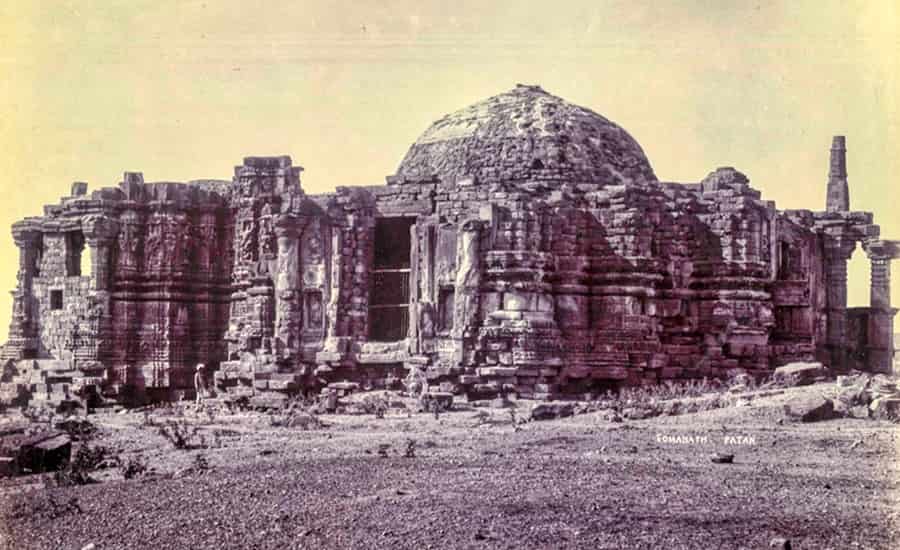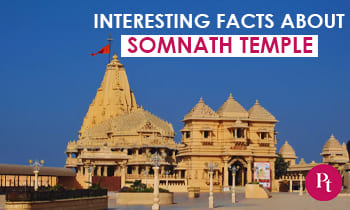The Somnath Temple, located in the western state of Gujarat, India, holds a significant place in the hearts of millions of devotees and is one of the most revered and ancient temples in the country. Its history is rich, filled with myths, legends, and a series of invasions and reconstructions. This article will delve into the history, mythology, and legends associated with the Somnath Temple, offering a comprehensive understanding of its cultural and religious importance.

Historical Overview
Early History
The history of the Somnath Temple dates back to ancient times. It is believed to have been originally built by the Moon God, Soma, and is dedicated to Lord Shiva, one of the principal deities in Hinduism. The name “Somnath” itself is derived from the combination of “Soma” and “nath,” meaning “Lord of the Moon.”
Invader’s Target
Throughout its long history, the temple has faced multiple invasions, most notably by Mahmud of Ghazni, a ruthless Afghan conqueror, in the 11th century. Mahmud’s raid resulted in the looting and destruction of the temple, which marked a significant turning point in its history. Subsequent rulers, including the Chalukya dynasty and the Mughals, contributed to the temple’s decline.
Reconstruction Efforts
Despite the destruction, the Somnath Temple was repeatedly rebuilt by various Hindu dynasties and kings. The rebuilding of the temple signifies not only the resilience of the Hindu faith but also the determination of devotees to revive their sacred site. Today’s Somnath Temple is the result of these reconstruction efforts.
Mythological Significance
Legend of the Moon God
The mythology surrounding the Somnath Temple is deeply rooted in Hindu religious texts and epics. According to one legend, the Moon God, Soma, had a curse placed upon him that caused his waning. In search of redemption and to regain his lost glory, Soma is said to have prayed to Lord Shiva at this very location. This act of devotion led to the establishment of the temple.
Lord Shiva’s Lingam
The central deity of the Somnath Temple is a Jyotirlinga, a sacred representation of Lord Shiva. This is one of the twelve Jyotirlingas in India, each believed to possess immense spiritual power. The Lingam symbolizes the endless and omnipresent nature of Lord Shiva and attracts devotees from far and wide.
Legends and Stories
The Tale of Mahmud of Ghazni
One of the most renowned legends associated with the Somnath Temple is the invasion by Mahmud of Ghazni in 1026 CE. Mahmud’s conquest was driven by his desire to plunder the temple’s riches. The brutal attack resulted in extensive damage and the looting of the temple’s treasures, including its gold, silver, and jewels.
Prithviraj Chauhan’s Redemption
In the later part of the 12th century, the Chaulukya dynasty, led by King Bhima I, embarked on a mission to reclaim and rebuild the Somnath Temple. They were successful in restoring it to its former glory. The temple was once again a symbol of Hindu resilience and resistance against foreign invaders.
The Mughal Influence
During the Mughal era, Emperor Aurangzeb attempted to demolish the Somnath Temple, which was already in a state of disrepair. While his efforts left the temple damaged, it was not completely destroyed. Subsequent rulers like Rani Ahilyabai Holkar undertook the task of reconstruction, ensuring the continuity of the temple’s worship.
Reconstruction Efforts
Rani Ahilyabai Holkar
Rani Ahilyabai Holkar, the Maratha queen, played a crucial role in the reconstruction of the Somnath Temple during the 18th century. She contributed significantly to the temple’s restoration, bringing it back to its former glory. Her efforts ensured that the temple continued to be a beacon of Hindu devotion.
Post-Independence Restoration
After India gained independence in 1947, significant efforts were made to further restore the temple. The Government of India, along with contributions from devotees, supported the reconstruction of the Somnath Temple, ensuring its preservation and continued worship.
Architectural and Cultural Significance
The Somnath Temple is renowned for its striking architecture, characterized by its intricate carvings, majestic spire, and the presence of the Arabian Sea on its shores. The temple stands as a testament to India’s rich architectural heritage and its deep-rooted cultural significance.
Modern Devotion and Pilgrimage
Today, the Somnath Temple remains a site of immense religious significance, attracting millions of pilgrims and tourists from around the world. Devotees visit to seek the blessings of Lord Shiva and to witness the spiritual aura that surrounds the temple.
Conclusion
The Somnath Temple is not merely a place of worship but also a repository of history, mythology, and legends that have shaped its destiny. Its resilience in the face of adversity and continuous reconstruction over the centuries have made it a symbol of Hindu faith and cultural heritage. The temple’s rich history, deep-rooted mythology, and enduring legends continue to captivate the hearts and minds of those who visit, making it a cherished and revered place of devotion and spirituality.










 Call
Call WhatsApp
WhatsApp Enquiry
Enquiry